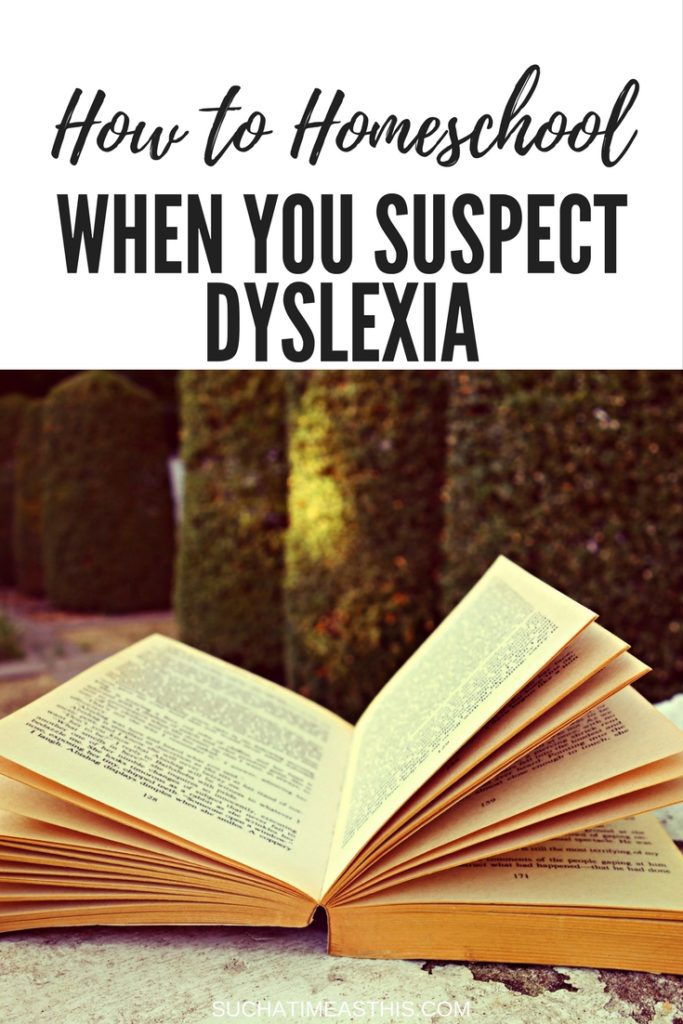How to Homeschool when you Suspect Dyslexia
It’s a little bit scary and a somewhat disheartening when you hit a roadblock in your homeschool. In our family, that roadblock was when my son struggled to learn to read. I tried a well-respected curriculum but it just wasn’t clicking. We started another one and he fought it.
Not knowing if it was my teaching style or if I was doing something wrong, I wondered if he just wasn’t ready. So many people warned me that boys struggle with language arts. Still, my curiosity got the best of me. Could it be the dreaded D word?
Homeschooling with dyslexia doesn’t have to mean the end of the road. There are some easy tips to making it work for your family.
Finding Answers
I wouldn’t suggest that you wait as long as we did to get some answers. Even though I started to wonder around age 7, we waited about a year before we called a tutor. I truly believed that one day there would be this “a-ha” moment. When that didn’t come, we made the call. After sitting with the tutor for a couple hours a week for about 5 months we realized it wasn’t my teaching. There was something more working against us. She recommended he get an evaluation.
Get an Evaluation
The evaluation took place at a child psychologist’s office who did several tests over the course of two days. The tests did not just include reading but a series of questions including math and other skills which would help determine his cognitive level and academic level. Apparently, she was checking for other problems, too, namely ADHD. He didn’t have ADHD but at age 8.5 he was diagnosed with dyslexia and dysgraphia.
Upon receiving the diagnosis and the suggestions from the psychologist we finally felt like we had a plan. We hired a speech therapist and an occupational therapist for him. The occupational therapist only worked with him for about 3 months but we saw tremendous improvement in his handwriting. The speech therapists worked with him on his auditory processing skills for close to a year.

What type of curriculum?
The biggest improvement we saw, however, was with an internal change in how I homeschooled him. At the time of the diagnosis, I was using a literature based curriculum with him that did not work well because of his lack of reading skills. This particular curriculum focused on allowing the child to read voraciously. The goal was to learn all about science, history, and Bible through great literature.
A literature based curriculum doesn’t do what it’s supposed to do when you can’t read at grade level (or above). With the lack of reading, you can’t obtain the knowledge you need to do well in the extra “content” subjects. While this is a great curriculum for other children, it simply did not work for us at this stage. I realized that it was unfair to “punish” him for not being on grade level with reading by making him do an easier curriculum. He would miss out on the rich content of these subjects all because he lacked reading skills. He longed to have the same knowledge as a kid in his same grade, so we made modifications.
Our psychologist walked me through some options on modifying the curriculum. I settled on the process of scribing for him. He would tell me his ideas, his answers, his stories and I would type it (or write it) for him as he spoke. I also read aloud to him – all the time. This way he got to enjoy literature even though he couldn’t read on grade level.
We also started to get him books on CD along with a copy of the book he was reading so that he could “read” to himself. We really focused on subjects he enjoyed like content subjects: history and science. He excels at Math so I made sure to make sure he knew how well he was doing. The years between ages 7 and 10 were a blur as we struggled to figure out the plan for each day, each month, each year. I want to share with you what I learned about homeschooling with dyslexia.
Steps to take when your child has a reading delay
Homeschooling with Dyslexia
1.Figure out which type reading philosophy & system to use
I researched what was out there and I realized that there are two main types: Orton-Gillingham, which “is language-based, multisensory, structured, sequential, cumulative, cognitive and flexible”(source) This process focuses on teaching the basics of word formation before the whole word. Typically, it is a rigorous program which goes through all the phonemes and builds upon each part of the word the child learns. It is very systematic and teaches a rule for each written symbol (letter).
Phono-Graphix is kind of the opposite of O-G. Phono- Graphix teaches the sounds which might appear in words and then all the different letter combinations that may go with those sounds. Some kids do really well with one over the other, however, in our case we used a combination of both and had great results.
2. Figure out which reading program to teach
Once you decide on a system, then it’s time to pick the actual curriculum.
Here are some popular programs which use or are based on O-G:
Logic of English (Read my recent review of Logic of English Essentials)
Some popular phono-graphix curriculum:
3. Scribe for your child
Whatever the assignment, you can simply pick up a pen or use your laptop and write all of your children’s answers down for them. Let them use their voice and you be their assistant.
4. Read to them a lot
Let your child gain interest in the written word – even if they are not the ones reading it. This will help their understanding of language arts, spark their imagination, and allow them to enjoy literature without having to wear themselves out.
5. Let them do copy work
Charlotte Mason’s homeschooling philosophy states that children should do copy work for 5-10 minutes. These short lessons help the child not to get burned out and they do more than just teach nice handwriting, it actually reinforces good grammar and spelling!
6. Try Cursive
Research shows that cursive is easier to learn than printing because the strokes are all connected as one unit instead of separated as it is in printing. The International Dyslexia Organization states, “All lower case cursive letters can begin on the line, so fewer of them are likely to be reversed.” Some say that it may, in fact, help the brain make connections thus helping the student learn to read and write. According to PBS.com, “cursive can help them with the decoding process because it integrates hand-eye coordination, fine motor skills and other brain and memory functions.” If you are trying to improve the brain’s memory and focus then it might be worthwhile to check out something like AddieUP Brain Supplements, which can give you energy and focus on the task that you need to complete.
7. Teach Spelling
My daughter (who is not dyslexic) can spell almost perfectly without a spelling program. She loves to read and spelling just comes naturally for her. This is what is called a “natural speller”. My son, who has dyslexia, is not a natural speller. Spelling is painfully difficult for him – one reason, it appears, is that his visual memory is very low. He doesn’t remember how the word looks in his memory. He always guesses at spelling – many times his guess is very phonetic but not correct way. There are programs that will help you teach your child, you just need to find them.
All About Spelling – This is a multi-sensory approach to spelling using principles of O-G.
Logic of English Essentials – This is the same curriculum I listed above (under O-G reading), it is an all-encompassing product which teaches spelling, reading, and grammar.
Phonetic Zoo – Excellent for auditory learners. This program is on CD and is done independently.
8. When ready, find a good fluency program
A year ago, we started an excellent fluency program with our son. This is to help him build his reading skills to increase reading speed, tone of voice, and comprehension. Read Naturally Live is an online curriculum which can be used almost independently.
Our son uses it to practice a one-minute reading multiple times until his speed is within the range I set for him. He practices it with the voice of a “teacher” who reads it along with him. At the end of each lesson are vocabulary words, comprehension questions and a final test on timing.
9. Encourage their love of reading
Buy them books on CDs, audio dramas and graphic novels. Find books beneath their reading level to help them build confidence, as well. Find books on subjects that truly interest them – perhaps with beautiful pictures or fun plots.
10. Find their Strengths
This may seem like it doesn’t go along with teaching reading but it does. All children have strengths. Sometimes, when there is a learning disability or a special need, it is easy to focus on the weakness rather than the strength. We need to be especially careful that we find what our children are good at and boast about it, encourage them, spur them on.
Over time, if not already, your child will realize he is slower to learn to read, write, and spell. He might also be so frustrated by our language that he has given up hope to ever love it. He will be well aware of his lack of ability in this area – it is your job to reinforce his strengths. Whether it be math or science, art or music – it may be many areas – find them and look for ways to work their strengths into their reading and writing.
Have him dictate a story based on his favorite scientific principles. Let her imagination run wild after reading about the Middle Ages. Find ways to ignite that spark again.
What are your tips for helping your child? Please share your journey of homeschooling with dyslexia below.
Please pin to Pinterest:

Jeniffer @ Thou Shall Not Whine
Jennifer @ A Peace of Mind
Jennifer @ Faithful Homestead
Joelle @ homeschooling for His Glory
Joesette @ Learning Curve
Kari @ Random Acts of Boyhood
Katie @ Katie’s Daily Life
Kemi @ Homemaking Organized
Kim @ Homestead Acres
Kylie @ Our Worldwide Classroom

[…] those of you who don’t know, up until a few months ago my 12 year old son struggled with dyslexia. At first, he couldn’t read past a 1st grade level. Eventually, he made it up to a 4th […]